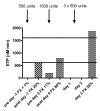Blood product support for delivery in severe factor X deficiency: the use of thrombin generation to guide therapy
- PMID: 19204776
- PMCID: PMC2581915
- DOI: 10.2450/2007.0023-07
Blood product support for delivery in severe factor X deficiency: the use of thrombin generation to guide therapy
Abstract
Background: Severe FX deficiency is a rare disorder with a variable bleeding tendency but spontaneous life threatening haemorrhage can occur. Treatment for invasive procedures and spontaneous bleeding is with prothrombin complex concentrates (PCC). When used in large or repetitive doses these are associated with a thrombotic tendency. FX:C levels of 0.15 - 0.30 IU/ mL are thought to be haemostatic during surgery . There is only limited information on the outcome and management of pregnancy in severe FX deficiency. Caesarean section is suggested as delivery mode to reduce the risk of intracranial/abdominal neonatal haemorrhage, but successful vaginal deliveries are also described. The calibrated automated thrombin generation assay (CAT) is a global coagulation test that measures the time course of thrombin generation. It has been reported to correlate with prothrombotic states and the severity of bleeding in rare coagulation disorders. The variability in phenotype, the uncertainty of the minimal haemostatic FX:C concentration and the association of PCC's with thrombosis make thrombin generation of interest in the management of FX deficient patients.
Patient: We describe the use of CAT as a possible means to monitor treatment with PCC (Beriplex) in a patient with severe FX deficiency (FX:C < 0.01 IU/mL) during successful vaginal delivery and epidural anaesthesia.
Results: Thrombin generation was normal at FX:C 0.80 IU/mL but only borderline normal at FX:C 0.25 IU/mL. Repetitive doses over 3 days increased thrombin generation to the upper limit of normal at FX:C 0.25 IU/mL consistent with a prothrombotic tendency after multiple doses. The increase in thrombin generation was not related to prothrombin levels.
Conclusion: The data suggest that CAT may be used to monitor treatment with PCC in FX deficiency. Higher levels than previously thought may be needed to normalize thrombin generation. Further studies into the correlation with bleeding or thrombosis are needed before the approach can be accepted in clinical practice.
Keywords: FX deficiency; endogenous thrombin potential; pregnancy; prothrombin complex concentrate; thrombin generation.
Figures








References
-
- Mannucci PM, Duga S, Peyvandi F. Recessively inherited coagulation disorders. Blood. 2004;104:1243–52. - PubMed
-
- Bolton-Maggs PH, Perry DJ, Chalmers EA, et al. The rare coagulation disorders—review with guidelines for management from the United Kingdom Haemophilia Centre Doctors’ Organisation. Haemophilia. 2004;10:593–628. - PubMed
-
- UKHCDO. Guidelines on the selection and use of therapeutic products to treat haemophilia and other hereditary bleeding disorders. Haemophilia. 2003;9:1–23. - PubMed
-
- Kohler M. Thrombogenicity of prothrombin complex concentrates. [Review] Thrombosis Research. 1999;95:S13–S17. - PubMed
-
- Romagnolo C, Burati S, Ciaffoni S, et al. Severe factor X deficiency in pregnancy: case report and review of the literature. Haemophilia. 2004;10:665–8. - PubMed
LinkOut - more resources
Full Text Sources
Miscellaneous
